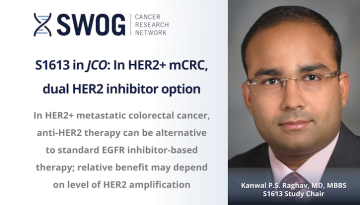Learning Even More from Our Patients
Volunteers on our studies contribute the biospecimens that are the raw materials for our correlative science research, and we owe it to them, as well as to future patients, to use those resources efficiently to interpret study results, generate new knowledge, and develop tomorrow's clinical trials.
But there’s plenty of room for improvement in how we do correlative science.
The chairs of the six adult and pediatric NCTN cooperative groups have published a position paper in the Journal of Clinical Oncology that outlines many of those potential improvements.
“Correlative Science in the Cooperative Group System—Re-Engineering for Success” details a route to a better future for translational research in the NCTN.
We’ve also issued a joint press release to help the paper reach a wider audience.
The primary limit on the current system is insufficient cash – “chronic underfunding of translational science at every stage, from sample acquisition and accession to the tissue banks, to tissue availability, distribution, and analysis” (we didn’t mince words).
Compounding this, it can also be challenging to bring in external monies for correlative science, as potential funding partners can be hesitant to sign an agreement with an NCTN group when the biospecimens are under NCI jurisdiction and the review process for accessing them can be lengthy and uncertain.
As a key route to attracting badly needed funding for our correlative science, our J Clin Oncol paper proposes an expanded model of public-private partnerships.
It would allow the groups to enter directly into two-way agreements with funding partners for collecting and using biospecimens for correlative research and would give the groups custody over the samples collected. Direct, two-way agreements with funding partners would simplify contracting and negotiation of elements such as intellectual property rights. They would make it easier to attract resources to directly support the collection and storage of biospecimens and could help ensure that translational science projects are completed more quickly.
Our paper outlines some of the key stipulations that would be needed for such agreements, such as ensuring group investigators have access to all data generated and that results are published. It also discusses how data generated by translational projects under these agreements would be managed and made publicly available.
In addition to funding partners in this proposal having access to specimens, our model would ensure that collected specimens would be made publicly available for research by outside investigators.
Of course, the idea of enhanced public-private partnerships to drive more cooperative group correlative science is nothing new.
In fact, one recommendation made in the 2010 report by the then Institute of Medicine – the report that helped drive the transformation of the cooperative group system of that era into today’s NCTN – was that the NCI should facilitate “the creation of more public-private partnerships” and “the development of appropriate hybrid funding models, in which NCI and industry support clearly defined components of trials that are of mutual interest.”
Our position paper is simply the next (perhaps overdue) step in realizing this vision for enriching our correlative science components.
The paper also recognizes and draws on successful models already in place in NCTN trials, including those for ComboMATCH and, of course, Lung-MAP.
We’ve amassed more than a decade of experience with Lung-MAP’s unique public-private partnership. We know it works; we’ve summarized the lessons learned; and we can use lessons learned to build what’s next.
The number and reach of such partnerships are almost certain to grow in the coming years. Last fall, I took part in a workshop sponsored by the National Academies that foresaw and planned for this future. “Optimizing public-private partnerships for clinical cancer research” explored opportunities to improve care and outcomes for patients with cancer through public-private partnerships supporting clinical research (the workshop proceedings are free for the reading).
There’s much more we proposed in the manuscript, including specific changes to lower some of the barriers researchers now face in accessing and using biospecimens from our trials. But the key component is a new model to strengthen funding for conducting translational research alongside our clinical trials. The two advance together, informing each other, and both need to be well resourced.
We owe no less to those many thousands of past volunteers on our clinical trials who have given of themselves freely in the hope of helping future patients with cancer. We have much more we can be learning from their gifts.
Our New Theranostics Subcommittee and Chair
I’ll close with a breaking news headline: this week I appointed Dr. Jeffrey Wong, who co-directs the theranostics program at City of Hope, as inaugural chair of SWOG’s theranostics subcommittee, a new and exciting joint venture of our radiation oncology and imaging committees.
I’ll have much more to say about this initiative and about Dr. Wong in a future Front Line, but I didn’t want to delay this announcement.
A big thank you to the search committee for your great work, and welcome to your new role Dr. Wong!
Other Recent Stories



